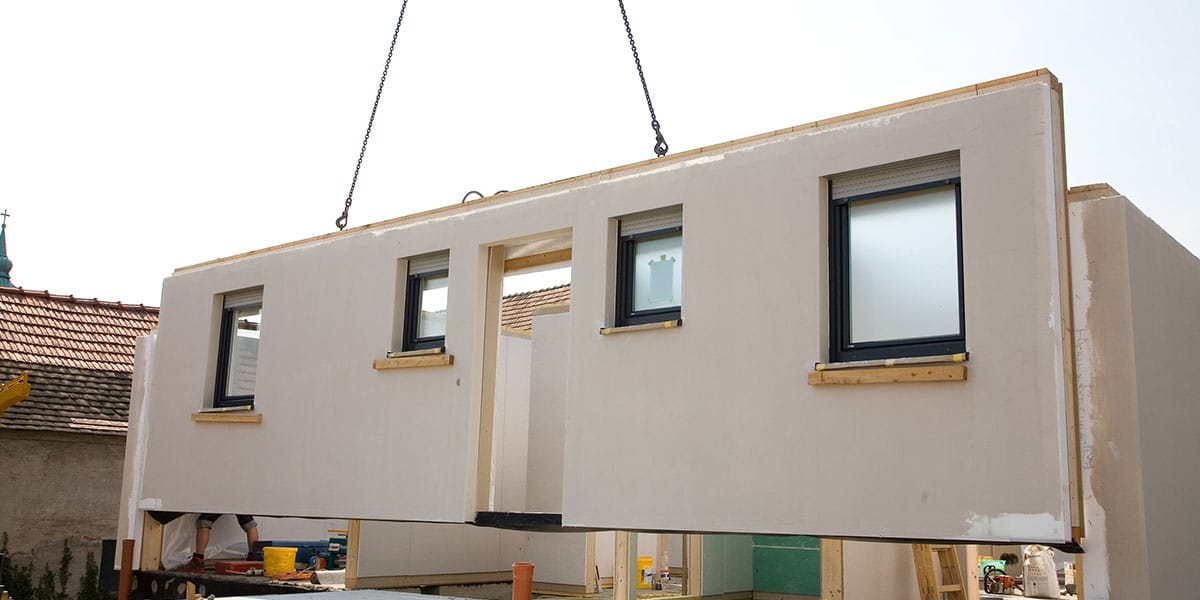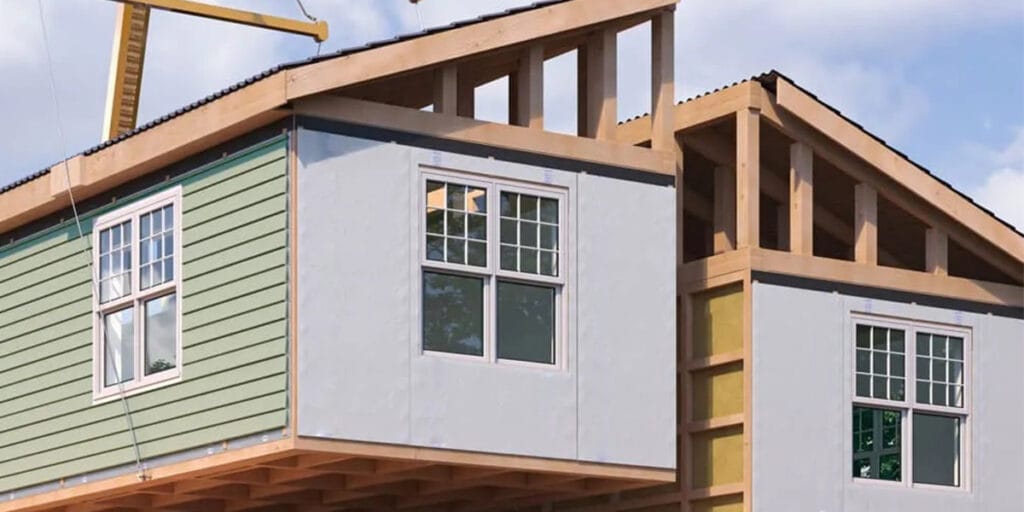
20 May What Are Structural Insulated Panels Used For In Green Construction
Table of Contents
Structural insulated panels (SIPs) make building eco-friendly homes easier. These panels give great insulation, keeping buildings energy-efficient. Using SIPs for walls, roofs, and floors stops air leaks. This helps cut heat loss and saves energy. A study found that multifamily buildings saved up to 70% energy with better insulation systems. As more people want green buildings, SIPs are now very popular. They reduce waste and boost energy savings, making them perfect for green construction.
Key Takeaways
Structural insulated panels (SIPs) keep heat in or out well. This lowers energy use by 40% to 60% compared to normal building ways.
SIPs help cut heating and cooling costs a lot. Homeowners can save up to 60% on energy bills.
SIPs are made with eco-friendly materials, which means less waste. This supports green building methods.
SIPs make building faster because they come ready to use. This saves time and cuts labor costs.
Using SIPs can help buildings get green awards like LEED. This makes them worth more and better for the planet.
Energy Efficiency of Structural Insulated Panels
How SIPs reduce energy consumption
Structural insulated panels (SIPs) help cut energy use in buildings. They have a foam core between two strong outer layers. This design makes them very insulated and airtight. SIPs are 40% to 60% more energy-saving than regular building methods. Many SIP homes score 50 or less on the HERS scale. This means they use half the energy of normal new homes. SIPs work well because they stop heat transfer and air leaks, which are common in regular buildings.
Making SIPs also uses less energy than other materials. For example, making EPS foam, used in many SIPs, takes 24% less energy than fiberglass insulation. Over 50 years, SIPs save 120 times the energy used to make them. This makes them a great choice for lowering energy use in buildings.
Thermal performance and airtightness
SIPs are great at keeping heat in or out of buildings. They provide solid insulation without gaps or weak spots. This keeps buildings warm in winter and cool in summer, making them comfy all year.
Tests show SIPs stay airtight even in tough conditions. A hut made with SIPs was tested in freezing climates. The sealed joints kept it very airtight. But proper installation is key, as tricky joints can leak air or trap moisture. Even with these challenges, SIPs are up to 15 times more airtight than regular buildings in tests.
Lower heating and cooling costs
Using SIPs can save a lot on heating and cooling bills. Buildings with SIPs often cut these costs by up to 60%. This is because SIPs stop energy loss through leaks and weak spots.
These savings lower bills and help meet green building goals. For example, SIP homes can qualify for the Zero Energy Ready Home program. These homes use very little energy for heating and cooling. SIPs save money and help the environment, making them a smart choice for green building projects.
Environmental Benefits of Structural Insulated Panels
Use of sustainable and renewable materials
Structural insulated panels (SIPs) use eco-friendly and renewable materials. The outer layers, often made of oriented strand board (OSB), use about 80% of harvested wood. This smart use of wood lowers the need for extra logging. SIPs also use much less wood than regular homes, making them better for the environment.
The core of SIPs, usually made of expanded polystyrene (EPS), is also eco-friendly. Making EPS takes 24% less energy than making fiberglass insulation with the same R-value. Some SIPs even use recycled fibers or other creative materials, adding to their green benefits. Choosing SIPs helps protect forests and supports renewable resources.
Evidence Type | Description |
|---|---|
SIPs are airtight and insulated, cutting energy use for heating and cooling. | |
Environmental Impact | SIPs use sustainable materials, helping protect the environment. |
Innovative Materials | SIPs can include recycled fibers, boosting their eco-friendliness. |
Waste reduction during construction
Using SIPs cuts down on waste during building projects. They are made in factories with exact measurements, so less material is wasted. Unlike traditional methods, which need cutting and trimming on-site, SIPs come ready to use. This means fewer leftovers that would go to landfills.
SIPs also need fewer materials overall. For example, SIP homes use much less wood than stick-frame homes. By reducing waste, SIPs save resources and lower the environmental impact of construction.
Contribution to green certifications like LEED
SIPs can help buildings earn green certifications like LEED (Leadership in Energy and Environmental Design). These awards are for buildings that are very eco-friendly and energy-efficient. SIPs help earn LEED points in areas like energy savings, material use, and waste reduction.
SIPs’ airtight and insulated design improves energy efficiency, which is important for LEED. Their use of green materials and reduced waste also matches LEED’s goals. Adding SIPs to your project helps create a building that meets strict green standards and lowers its carbon footprint.
Construction Advantages of Structural Insulated Panels
Faster construction timelines
Structural insulated panels (SIPs) help finish building projects quicker. These panels are made in factories and arrive ready to use. Builders don’t need to spend time cutting or adjusting them on-site. For example, a housing project in Manchester, UK, finished 40% faster with SIPs. Another office project in London cut its building time by 30%.
Project Name | Location | Time Saved | Cost Saved | Year Finished |
|---|---|---|---|---|
Apex Housing Development | Manchester, UK | 40% | 30% | 2022 |
Nightingale Village | Melbourne, AU | 25% | N/A | N/A |
B1M4 Office Complex | London, UK | 30% | 20% | N/A |
Using SIPs makes construction faster and saves both time and money.
Reduced labor requirements
SIPs also lower the number of workers needed for building. A study showed that building a two-story home with SIPs saved 130 labor hours. This is 55% less work compared to regular framing methods. Cost data shows SIPs make building easier and cheaper. With fewer workers needed, you can save money and use resources better.
Consistent quality and durability
SIPs are strong and last a long time, keeping buildings safe. Tests show SIPs meet strict standards for handling heavy loads. For example, 6.5-inch SIPs bent only 0.27 to 0.50 inches under pressure. Larger 12.25-inch SIPs bent 0.41 to 0.66 inches, which is still acceptable. SIPs also pass important building safety rules. Using SIPs ensures your projects stay high-quality and durable for years.
Health and Comfort with Structural Insulated Panels

Improved indoor air quality
Structural insulated panels (SIPs) help make indoor air healthier. Their tight design keeps outdoor pollutants out of your home. This lowers exposure to allergens and harmful particles that can cause breathing problems. SIPs also work well with special ventilation systems. These systems clean the air and keep it fresh, reducing the chance of mold.
SIPs are also free from harmful chemicals like VOCs (volatile organic compounds). You don’t need to worry about toxic fumes in your home. Choosing SIPs creates a safer and more comfortable space for everyone.
How SIPs improve air quality:
No harmful VOCs or chemicals.
Airtight design blocks pollutants.
Ventilation systems clean and refresh air.
Noise reduction and thermal comfort
SIPs make homes quieter and more comfortable. Their solid build reduces noise from outside, creating a peaceful space. If you live near traffic or loud areas, SIPs help block unwanted sounds.
They also keep indoor temperatures steady. SIPs stop drafts and provide great insulation, so rooms stay cozy. You won’t have hot or cold spots, even in extreme weather. Compared to regular building methods, SIPs are better at controlling noise and temperature.
Feature | SIPs (4-inch R-14) | Traditional (2×6 R-19) |
|---|---|---|
Energy Efficiency | Higher energy use | |
Airtightness | 15x more airtight | Less airtight |
Noise Insulation | Better soundproofing | Standard soundproofing |
Drafts | Fewer drafts | More drafts |
Indoor Temperature Consistency | Steady temperature | Uneven temperature |
Long-term performance and durability
SIPs are strong and last a very long time. With good care, SIP homes can last 60 to 100 years. Studies show they stay sturdy and keep insulating well for decades. You won’t face common problems like warping, rotting, or settling.
Real-life examples prove their strength. Some SIP buildings have lasted over 90 years without major issues. Their airtight design also protects the structure, saving energy and extending the home’s life. SIPs are a durable choice that keeps homes efficient and comfortable for many years.
Evidence Type | Details |
|---|---|
Lifespan | SIP homes last 60 to 100 years with proper care. |
Long-Term Studies | SIPs stay strong and insulated for decades. |
Real-Life Examples | Some SIP buildings have lasted over 90 years. |
Resistance to Aging | SIPs resist warping, rotting, and settling better than other materials. |
Energy Efficiency | Airtight design saves energy and protects the structure. |
Structural insulated panels are great for eco-friendly building projects. They use less energy, cut waste, and make homes more comfortable. These panels also lower carbon emissions. The average U.S. home releases 22,000 pounds of CO2 each year. SIP homes save 50%-70% more energy than the Model Energy Code when paired with efficient systems. Studies by Oak Ridge National Laboratory show SIPs insulate better than regular walls.
Benefit Type | Evidence |
|---|---|
Lower Carbon Emissions | SIPs reduce CO2 from homes, which release 22,000 lbs yearly. |
Energy Savings | SIP homes save 50%-70% energy with efficient systems. |
Better Insulation | A study found 3.5-inch EPS core SIPs insulate better than regular walls. |
Using SIPs helps the planet and earns green certifications for your projects.
FAQ
What are Structural Insulated Panels (SIPs) made of?
SIPs have a foam core between two strong outer layers. These layers are usually made of oriented strand board (OSB). The foam gives insulation, and the outer layers add strength.
Tip: Choose SIPs with recycled foam or eco-friendly OSB for greener building. 🌱
Can SIPs be used in all types of buildings?
Yes, SIPs can be used in many building types. They work for homes, offices, and industrial spaces. SIPs are great for walls, roofs, and floors, fitting different designs.
Examples of SIP uses:
Houses
Office spaces
Schools or community buildings
How do SIPs improve energy efficiency?
SIPs save energy by sealing buildings tightly and insulating well. They stop heat from escaping and block air leaks. This keeps homes warm in winter and cool in summer.
Note: Buildings with SIPs often use 40%-60% less energy than regular ones. 💡
Are SIPs environmentally friendly?
Yes, SIPs are good for the environment. They use green materials, create less waste, and save energy. Their long life means fewer repairs or replacements are needed.
Eco Benefits of SIPs | Details |
|---|---|
Sustainable Materials | OSB and foam cores are eco-friendly. |
Waste Reduction | Factory-made, less leftover waste. |
Energy Savings | Lowers heating and cooling needs. |
Do SIPs require special maintenance?
No, SIPs are easy to maintain. They resist pests, warping, and rotting. With proper setup and checks, they last for decades.
Reminder: Check for moisture near joints to keep them airtight and insulated. 🛠️
